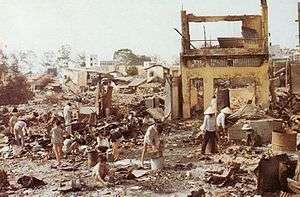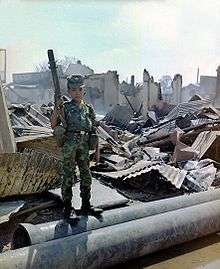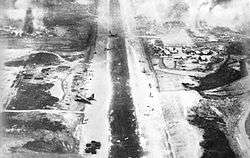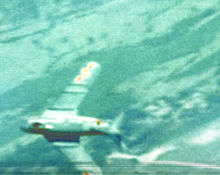1968 in the Vietnam War
| 1968 in the Vietnam War | |||||
|---|---|---|---|---|---|
 Cholon after Tet Offensive operations 2016 | |||||
| |||||
| Belligerents | |||||
|
Anti-Communist forces: |
Communist forces: | ||||
| Strength | |||||
|
US: 549,500 [1] | NVA/VC: 420,000 [5] | ||||
| Casualties and losses | |||||
|
US: 16,592 killed [6] 87,388 wounded[7] South Vietnam: 27,915 killed [8] 172,512 wounded[7] | Unknown (US estimates: 191,000 [9] - 208,254 killed [5][A 1]) | ||||
The year 1968 saw major developments in the Vietnam War. The military operations started with an attack on a US base by the Vietnam People's Army (NVA) and the Viet Cong on January 1, ending a truce declared by the Pope and agreed upon by all sides. At the end of January, the North Vietnamese and the Vietcong launched the Tet Offensive. Although militarily the operation was a failure for the Vietnamese communists, for them it was a propaganda victory, as on the home front the American public were shocked by the images they were seeing on their televisions.
Reflecting this public outrage the media made a number of iconic news stories including Peter Arnett quoting an unnamed US major as saying, "It became necessary to destroy the town to save it." Eddie Adams' iconic image of South Vietnamese General Nguyễn Ngọc Loan's execution of a Vietcong operative was taken in 1968. The year also saw Walter Cronkite's call to honourably exit Vietnam because he thought the war was lost. This negative impression forced the US into the Paris peace talks with North Vietnam.
US troop numbers peaked in 1969 with President Johnson approving an increased maximum number of US troops in Vietnam at 549,500. The year was the most expensive in the Vietnam war with the American spending US$77.4 billion (US$ 527 billion in 2016) on the war. The year also became the deadliest of the Vietnam War for America and its allies with 27,915 South Vietnamese (ARVN) soldiers killed and the Americans suffering 16,592 killed compared to around two hundred thousand of the communist forces killed. The deadliest week of the Vietnam War for the USA was during the Tet Offensive specifically February 11–17, 1968, during which period 543 Americans were killed in action, and 2547 were wounded.
January

- January 1
The North Vietnamese Army violated a New Year's truce. At the New Year's Day Battle of 1968 among the Americans were future writer Larry Heinemann and future film director Oliver Stone.[11][12]
In Newsweek magazine Ambassador Robert Komer touted the early success of the Civil Operations and Revolutionary Development Support (CORDS) pacification program he led. He said that "only one South Vietnamese in six now lives under VC [Viet Cong] control."[13]
- 19 January
In the first two weeks of 1968, communist forces shelled 49 district and provincial capitals in South Vietnam and temporarily occupied two of them. The Commander of the Military Assistance Command Vietnam (MACV) General William Westmoreland described to Time (Magazine) the fighting "as the most intense of the entire war." MACV claimed that 5,000 communist forces had been killed.[14]
- 21 January
The long and bloody Battle of Khe Sanh began with an assault by the North Vietnamese Army on a hill held by U.S. Marines. Khe Sanh is in northwestern Quảng Trị Province, near the Demilitarized Zone. The combatants were elements of the U.S. III Marine Amphibious Force (III MAF) and Army of the Republic of Vietnam (ARVN) against two to three division-size elements of the People's Army of Vietnam (PAVN).[15] NVA General Vo Nguyen Giap later explained that his objective was to create a diversion to draw U.S. forces away from the populated areas of South Vietnam. Khe Sanh diverted 30,000 US troops away from the cities that would be the main targets of the Tet Offensive.[16]
- January 23–24, 1968
Battle of Ban Houei Sane was a battle of the Vietnam War that began on the night of 23 January 1968, when the 24th Regiment of the North Vietnamese 304th Division overran the small Laotian Army outpost at Ban Houei Sane.[17]
- January 24 − March 1
Operation Coburg was an Australian military action during the Vietnam War. The operation saw heavy fighting between the 1st Australian Task Force (1ATF) and North Vietnamese Army and Viet Cong during the wider fighting around Long Binh and Biên Hòa.[18]
- 26 January
In Time Magazine, General Westmoreland said, "the Communists seem to have run temporarily out of steam."[19]
- 28 January
General Westmoreland in his annual report said "In many areas the enemy has been driven away from the population centers; in others he has been compelled to disperse and evade contact thus nullifying much of his potential. The year ended with the enemy increasingly resorting to desperation tactics in attempting to achieve military/psychological victory; and he has experienced only failure in those attempts."[20]
Tet Offensive

- January 29
At half-past midnight on Wednesday morning the North Vietnamese launch the Tet Offensive at Nha Trang. At 2:45 that morning the US embassy in Saigon is invaded and while they could not gain entry it was held until 9:15AM.[21]
- January 31 – March 7
The Battle of Saigon was first fought during the Tet Offensive of the Vietnam War was the coordinated attack by communist forces, including both the North Vietnamese Army and the Viet Cong, against Saigon, the capital of South Vietnam.[22]
- January 30 – March 3
The Battle of Huế was one of the bloodiest and longest battles. The Army of the Republic of Vietnam and three understrength U.S. Marine Corps battalions attacked and defeated more than 10,000 entrenched People's Army of Vietnam (PAVN) and National Front for the Liberation of South Vietnam (NLF, also known as, Viet Cong) guerrilla forces.[23]
- February 1, 1968
One notable ARVN unit, the 3d Armored Cavalry Squadron, fought a pitched battle with the Liberation Front’s H-15 Local Force Battalion in or near Pleiku.[24] They were later awarded the United States Presidential Unit Citation for extraordinary heroism against hostile forces during the Tet Offensive, making them one of only a few non-U.S. military units to receive the highest U.S. military honor awarded at the unit level. [25]
February
- February 1
During South Vietnamese action following the first day of the Tet offensive General Nguyễn Ngọc Loan is captured on film executing a Viet Cong prisoner by American photographer Eddie Adams. The Pulitzer Prize-winning photograph becomes yet another rallying point for anti-war protesters.[26]
- February 6 - February 7
The Battle of Lang Vei was a battle of the Vietnam War fought on the night of 6 February 1968, between elements of the People's Army of Vietnam (PAVN) and the United States-led Detachment A-101, 5th Special Forces Group.[17]

- February 7
International reporters arrive at the embattled city of Bến Tre in South Vietnam. Peter Arnett, then of the Associated Press, writes a dispatch quoting an unnamed US major as saying, "It became necessary to destroy the town to save it."[27]
- February 18
During the week of February 11–17, 1968 the record for the highest US casualty toll during one week was set. The record coming off after the Tet Offensive was 543 Americans killed in action, and 2547 wounded.[28]
- February 27
Walter Cronkite, reporting after his recent trip to Vietnam for his television special "Who, What, When, Where, Why?" gives a highly critical editorial and urges America to leave Vietnam "...not as victors, but as an honorable people who lived up to their pledge to defend democracy, and did the best they could."[29]
March
- March 10 – March 11
Battle of Lima Site 85 was a battle of the Vietnam War. The site was located at Phou Pha Thi, Laos.[30]
- March 16
US ground troops from Charlie Company of 1st Battalion, 20th Infantry Regiment, 11th Brigade, 23rd Infantry Division (the Americal Division) rampage through the hamlet of My Lai killing more than 500 Vietnamese civilians from infants to the elderly. The event would remain buried for more than a year.[31]
- March 31
President Lyndon Johnson delivers his Address to the Nation announcing steps to limit the war in Vietnam and reporting his decision not to seek reelection. The speech announces the first in a series of limitations on US bombing, promising to halt these activities above the 20th parallel.[32]
- March 31
United States Secretary of Defense Clark Clifford gets the President to authorize 24,500 more troops on an emergency basis, raising authorized strength to the Vietnam War's peak of 549,500, a figure never reached.[1]
April
- April 3 - 7th
A rescue operation for downing crew members of helicopter, Dustoff 65. The Operation undertaken by elements of the 101st ABN took 5days to find, rescue and extract the helicopter crew.
- April 8 - May 31
Operation Toan Thang I was a US and ARVN operation conducted between 8 April 1968 and 31 May 1968 in the Vietnam War. Toan Thang, or "Complete Victory", was part of a reaction to the Tet Offensive by forces allied with the Republic of Vietnam designed to put pressure on PLAF (Vietcong) and PAVN (North Vietnamese Army) forces.[33]
- April 19 - May 17
Operation Delaware was a military operation of the Vietnam War in the A Shau Valley. The A Shau Valley was an important corridor for moving supplies into South Vietnam and used as staging area for attacks. American and South Vietnamese had not been present in the area since the Battle of A Shau, when a Special Forces camp located there was overrun.[33]
May
- May 5
May Offensive was launched in the early morning hours of 4 May, in which communist units initiated PHASE II of the Tet Offensive of 1968 (also known as the May Offensive, "Little Tet", and "Mini-Tet") by striking 119 targets throughout South Vietnam, including Saigon.[34][35]
- May 10–12, 1968
The Battle of Kham Duc was the struggle for the United States Army Special Forces camp located in Quảng Tín Province, South Vietnam. The Kham Duc special forces camp was occupied by the 1st Special Forces detachment consisting of U.S and South Vietnamese special forces, as well as Montagnard irregulars.[36]

- May 12 – June 6
The Battle of Coral–Balmoral was a notable series of significant actions fought in May and June 1968 during the Vietnam War, between the 1st Australian Task Force (1 ATF) and communist forces, north-east of Saigon.[37]
- May 13
The first US and North Vietnamese delegations meet at the Paris peace talks to discuss American withdrawal.[38]
October
- October 8
Operation Sealords was launched on October 8, 1968, and was intended to disrupt North Vietnamese supply lines in and around the Mekong Delta. As a two-year operation, by 1971 all aspects of Sealords had been turned over to the South Vietnam Navy.[39]
- October 31
President Johnson announces a total halt to US bombing in North Vietnam.[40]
November

- November 1
After three-and-a-half years, Operation Rolling Thunder comes to an end. In total, the campaign had cost more than 900 American aircraft. Eight hundred and eighteen pilots are dead or missing, and hundreds are in captivity. Nearly 120 Vietnamese planes have been destroyed in air combat or accidents, or by friendly fire. According to U.S. estimates, 182,000 North Vietnamese civilians have been killed. Twenty thousand Chinese support personnel also have been casualties of the bombing.[41]
- November 5
Richard Nixon wins the 1968 presidential election in America. The results of the popular vote are 31,770,000 for Nixon, 43.4 percent of the total; 31,270,000 or 42.7 percent for Humphrey; 9,906,000 or 13.5 percent for Wallace; and 0.4 percent for other candidates.[42][43]
December
- December 1968 to May 11, 1969
Operation Speedy Express was a controversial United States military operation of the Vietnam War conducted in the Mekong Delta provinces Kien Hoa and Vĩnh Bình. The operation was launched to prevent NLF (Viet Cong) units from interfering with pacification efforts and to interdict lines of NLF communication and deny them the use of base areas.[33]
- December 12, 1968 – March 9, 1969
Operation Taylor Common was a search and destroy operation conducted by Task Force Yankee, a task organized force of the 1st Marine Division, during the Vietnam War. The objective was to clear the An Hoa Basin, neutralize the North Vietnamese Army's Base Area 112 and develop Fire Support Bases (FSBs) to interdict Communist infiltration routes leading from the Laotian border.[33]
Year in numbers
| Armed Force | Strength | KIA | Reference | Military costs - 1968 | Military costs in 2016 US$ | Reference | |
|---|---|---|---|---|---|---|---|
| |
820,000 | 27,915 | [2][8] | ||||
| |
549,500 | 16,592 | [6] | US$77,350,000,000 | US$ 527,238,330,000 | [44] | |
| |
50,000 | [3][4] | |||||
| |
6000 | [4] | |||||
| |
7660 | [4] | |||||
| |
1580 | [4] | |||||
| |
520 | [4] | |||||
| |
420,000 [5] | 191,000 - 208,254 (US estimates) | [5][9] |
Annotations
Bibliography
- Notes
- 1 2 United States Department of Defense 2010
- 1 2 "Facts about the Vietnam Veterans memorial collection". NPS.gov. 2010. Archived from the original on 28 May 2010. Retrieved April 26, 2010.
- 1 2 Leepson & Hannaford 1999, p. 209
- 1 2 3 4 5 6 7 8 9
War Remnants Museum Data
Armed Force 1964 1965 1966 1967 1968 1969 1970 1971 1972  South Vietnam ARVN
South Vietnam ARVN514,000 643,000 735,900 798,800 820,000 897,000 968,000 1,046,250 1,048,000  United States
United States 23,310 180,000 385,300 485,600 549,500 549,500 335,790 158,120 24,000  South Korea
South Korea 200 20,620 25,570 47,830 50,000 48,870 48,540 45,700 36,790  Australia
Australia 200 1560 4530 6820 7660 7670 6800 2000 130  Thailand
Thailand 0 20 240 2220 6000 11,570 11,570 6000 40  Philippines
Philippines 20 70 2060 2020 1580 190 70 50 50  New Zealand
New Zealand 30 120 160 530 520 550 440 100 50 - 1 2 3 4 Smith 2010
- 1 2 United States 2010
- 1 2 http://www.rjsmith.com/kia_tbl.html
- 1 2 Smedberg 2008, p. 196
- 1 2 Asprey 2002, p. 914
- ↑ Joes 2001, p. 99
- 1 2 Gaijinass (February 27, 2010). "Platoon: The story of Oliver Stone in Vietnam". gaijinass. Retrieved March 3, 2010.
- ↑ Bates 1996, p. 106
- ↑ Asprey, Robert B. (1994), War in the Shadows: The Guerrilla in History, New YorK: William Morrow and Company, p. 871
- ↑ Asprey, Robert P. (1994), War in the Shadows: The Guerrilla in History, New York: William Morrow and Company, p. 896
- ↑ Clarke, Bruce B. G. (2007), Expendable warriors: the Battle of Khe Sanh and the Vietnam War, Greenwood Publishing Group, p. 69
- ↑ Page, Tim and Pimlott, John Pimlott (1990) , Nam – The Vietnam Experience, 1965-75, London: Hamlyn, p. 324
- 1 2 Cash 1985, p. 111
- ↑ McNeill & Ekins 2003, p. 290
- ↑ Asprey, p. 896
- ↑ Asprey, p. 872
- ↑ Will banks 2008, pp. 34–36
- ↑ Watson & Oberholtzer 2010, p. 1
- ↑ Stanton 2003, p. 11
- ↑ "ARVN 3rd Cavalry Squadron fought a pitched battle". Retrieved 2010-06-11.
- ↑ "3d Armored Cavalry Squadron (ARVN) earned Presidential Unit Citation (United States) for extraordinary heroism" (PDF). Retrieved 2010-06-11.
- ↑ Lucas 2010
- ↑ New York Times 1968, p. 14
- ↑ AP 1968, p. 3
- ↑ Arnold 1990, p. 88
- ↑ Kelly 1996, p. 191
- ↑ Olson & Roberts 1998, p. 162
- ↑ Hamilton-Merritt 1993, p. 187
- 1 2 3 4 Stanton 2003, p. 12
- ↑ Nolan 2006, p. 21
- ↑ Davies & McKay 2005, p. 122
- ↑ Davies 2008, p. 169
- ↑ McAulay 1989, p. 777
- ↑ Hixson 2000, p. 274
- ↑ History.com 2010
- ↑ Hixson 2000, p. 280
- ↑ PBS (2010). "Battlefield Timeline". Public Broadcast Service. Archived from the original on 20 June 2010. Retrieved June 5, 2010.
- ↑ Boyer et al. Rieser, p. 696
- ↑ Brune & Burns 2003, p. 775
- ↑ Johnson 2004, p. 56
- References
- AP (Feb 21, 1968). "U.S. war toll sets record". Toledo Blade. Retrieved March 7, 2010.
- Arnold, James R. (1990). Tet Offensive 1968: turning point in Vietnam (1990 ed.). Osprey Publishing. ISBN 978-0-85045-960-9. - Total pages: 96
- Asprey, Robert B. (2002). War in the Shadows: The Guerrilla in History, Volume 2 (2002 ed.). iUniverse. ISBN 978-0-595-22594-1. - Total pages: 1281
- Bates, Milton J. (1996). The wars we took to Vietnam: cultural conflict and storytelling (1996 ed.). University of California Press. ISBN 978-0-520-20433-1. - Total pages: 328
- Boyer, Paul S.; Clark, Clifford; Hawley, Sandra; Kett, Joseph F.; Rieser, Andrew (2009). The Enduring Vision: A History of the American People, Volume 2: From 1865, Concise Volume 2 of The Enduring Vision (2009 ed.). Cengage Learning. ISBN 978-0-547-22278-3. - Total pages: 496
- Brune, Lester H.; Burns, Richard Dean (2003). Chronological History of U.S. Foreign Relations: 1932-1988 (2003 ed.). Routledge. ISBN 978-0-415-93916-4. - Total pages: 1549
- Cash, John A. (1985). Seven Firefights in Vietnam (1985 ed.). DIANE Publishing. ISBN 978-1-56806-563-2. - Total pages: 159
- Clarke, Bruce B. G. (2007). Expendable warriors: the Battle of Khe Sanh and the Vietnam War (2007 ed.). Greenwood Publishing Group. ISBN 978-0-275-99480-8. - Total pages: 167
- Davies, Bruce (2008). The Battle at Ngok Tavak: a bloody defeat in South Vietnam, 1968 (2008 ed.). Allen & Unwin. ISBN 978-1-74175-064-5. - Total pages: 250
- Davies, Bruce; McKay, Gary (2005). The men who persevered: the AATTV, the most highly decorated Australian unit of the Viet Nam War (2005 ed.). Allen & Unwin. ISBN 978-1-74114-425-3. - Total pages: 418
- Hamilton-Merritt, Jane (1993). Tragic mountains: the Hmong, the Americans, and the secret wars for Laos, 1942-1992 (1993 ed.). Indiana University Press. ISBN 978-0-253-20756-2. - Total pages: 580
- History.com (2010). "U.S. and South Vietnamese navies commence Operation Sealords". History.com. Archived from the original on 8 March 2010. Retrieved March 8, 2010.
- Hixson, Walter L. (2000). Leadership and diplomacy in the Vietnam War (2000 ed.). Taylor & Francis. ISBN 978-0-8153-3533-7. - Total pages: 354
- Joes, Anthony James (2001). The war for South Viet Nam, 1954-1975 (2001 ed.). Greenwood Publishing Group. ISBN 978-0-275-96807-6. - Total pages: 199
- Johnson, Chalmers A. (2004). The sorrows of empire: militarism, secrecy and the end of the republic (2004 ed.). Verso. ISBN 978-1-85984-578-3. - Total pages: 389
- Kelly, Orr (1996). From a dark sky: the story of U.S. Air Force Special Operations (1996 ed.). Presidio. ISBN 978-0-89141-520-6. - Total pages: 340
Leepson, Marc; Hannaford, Helen (1999). Webster's new world dictionary of the Vietnam War (1999 ed.). Macmillan. ISBN 978-0-02-862746-5. - Total pages: 598
- Lucas, Dean (2010). "Vietnam Execution". Famous Pictures Magazine. Archived from the original on 4 February 2010. Retrieved March 5, 2010.
- McAulay, Lex (1989). The Battle of Coral: Vietnam fire support bases Coral and Balmoral, May 1968 (1989 ed.). Arrow Australia. ISBN 978-0-09-169721-1. - Total pages: 361
- McNeill, Ian; Ekins, Ashley (2003). On the offensive: the Australian Army in the Vietnam War, January 1967-June 1968 (2003 ed.). Allen & Unwin. ISBN 978-1-86373-304-5. - Total pages: 650
- Nolan, Keith W. (2006). House to House: Playing the Enemy's Game in Saigon, May 1968 (2006 ed.). Zenith Imprint. ISBN 978-0-7603-2330-4. - Total pages: 368
- Olson, James Stuart; Roberts, Randy (1998). My Lai: a brief history with documents (1998 ed.). Palgrave Macmillan. ISBN 978-0-312-17767-6. - Total pages: 222
- Smedberg, Marco (2008). Vietnamkrigen: 1880–1980 (2008 ed.). Historiska media. ISBN 978-91-85507-88-7. - Total pages: 361
- Stanton, Shelby L. (2003). Vietnam order of battle (2003 ed.). Stackpole Books. ISBN 978-0-8117-0071-9. - Total pages: 396
- "Major Describes Move". The New York Times. February 8, 1968. Retrieved March 5, 2010.
- Smith, Ray (2010). "Casualties - US vs NVA/VC". rjsmith.com. Archived from the original on 15 April 2010. Retrieved March 22, 2010.
- Willbanks, James H. (2008). The Tet Offensive: A Concise History (2008 ed.). Columbia University Press. ISBN 978-0-231-12841-4. - Total pages: 264
- United States, Government (2010). "Statistical information about casualties of the Vietnam War". National Archives and Records Administration. Archived from the original on 26 January 2010. Retrieved March 6, 2010.
- United States Department of Defense (2010). "Clark M. Clifford". United States Department of Defense. Archived from the original on 28 February 2010. Retrieved March 8, 2010.
- Watson, Andy, Historian, U.S. Army Military Police School; Oberholtzer, William A. (2010). "Looking Back in History:The Battle of Saigon Forty Years Ago" (PDF). United States Army:Fort Leonard Wood. Retrieved March 8, 2010.
| Vietnam War timeline |
|---|
|
↓ Viet Cong created │ 1955 │ 1956 │ 1957 │ 1958 │ 1959 │ 1960 │ 1961 │ 1962 │ 1963 │ 1964 │ 1965 │ 1966 │ 1967 │ 1968 │ 1969 │ 1970 │ 1971 │ 1972 │ 1973 │ 1974 │ 1975 |